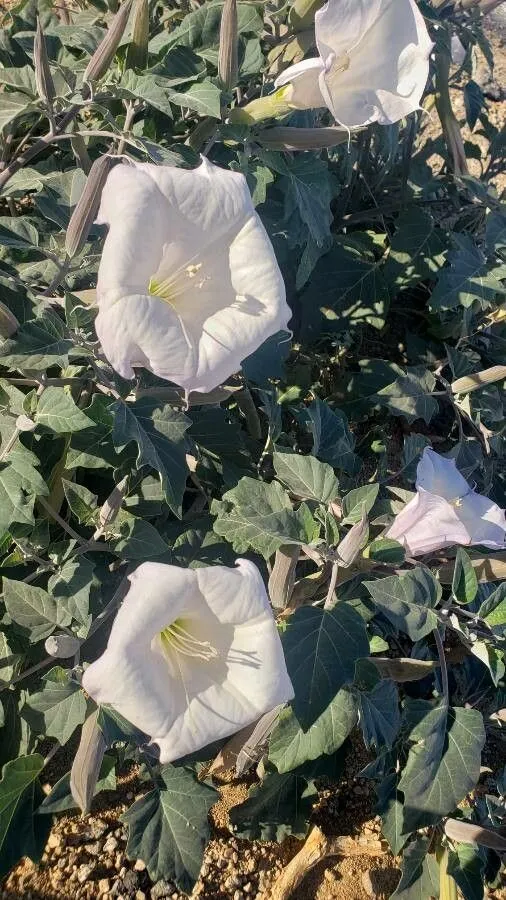
Author: Bernh.
Bibliography: Neues J. Pharm. Aerzte 26: 149 (1833)
Year: 1833
Status: accepted
Rank: species
Genus: Datura
Vegetable: False
Observations: WC. U.S.A. to Honduras
Desert thorn-apple, scientifically known as Datura discolor, is a captivating plant belonging to the Solanaceae family. This intriguing species is characterized by its unique and striking appearance, as well as its adaptability to arid environments, making it a fascinating subject for botanical enthusiasts and researchers alike.
The desert thorn-apple exhibits distinct features that distinguish it from other members of the Datura genus. It is renowned for its large, trumpet-shaped flowers that boast a delicate, often white, coloration with subtle hues of purple or green, particularly along the edges. These alluring blooms not only catch the eye but also emit a fragrance that attracts nighttime pollinators, such as moths. The serrated, lobed leaves of Datura discolor provide a textural contrast to its smooth, tubular flowers, enhancing the plant’s overall aesthetic appeal.
Geographically, Datura discolor spans a considerable range. It can be found in the wild from the western regions of the United States down through to Honduras in Central America. This extensive distribution indicates the plant’s remarkable adaptability to various climates and soil types, particularly thriving in desert landscapes where other flora might struggle to survive. The hardy nature of the desert thorn-apple allows it to persist in sandy, well-drained soils, with a resilience to the harsh conditions such environments present.
Historically, the taxonomy and the botanical characteristics of Datura discolor were detailed in the publication “Neues J. Pharm. Aerzte” in 1833, authored by Bernh., highlighting its longstanding recognition and study within the scientific community. This documentation underscores the plant’s botanical significance and the enduring interest it has sparked over centuries.
Desert thorn-apple not only enchants with its visual and olfactory allure but also serves as a subject of horticultural and ecological studies. Its role within its habitat, interactions with pollinators, and resilience mechanisms offer valuable insights into desert plant ecologies and the adaptive strategies of flora in extreme environments.
In summary, Datura discolor stands as a remarkable example of botanical beauty and adaptability. Whether appreciated for its ornamental value or studied for its ecological resilience, this desert thorn-apple remains a distinguished member of the diverse Solanaceae family, captivating and informative for all who encounter it.
Eng: desert thorn-apple
Swe: ökenspikklubba
En: Desert thorn-apple, Desert thornapple
Ar: داتورا مبقعة
Sv: Ökenspikklubba
Taken Oct 23, 2022 by Coli Bri (cc-by-sa)
Taken Apr 11, 2021 by erick cuevas (cc-by-sa)
Taken Sep 26, 2022 by ali baca (cc-by-sa)
Taken Aug 25, 2021 by Terry Miller (cc-by-sa)
Taken Sep 3, 2014 by EOL − Francisco Farriols Sarabia (cc-by)
Taken Sep 14, 2014 by EOL − Francisco Farriols Sarabia (cc-by)
Taken Jun 7, 2022 by Francisco Pendrake (cc-by-sa)
Taken Jun 7, 2022 by Francisco Pendrake (cc-by-sa)
Growth habit>: Forb/herb
Family: Myrtaceae Author: (F.Muell.) K.D.Hill & L.A.S.Johnson Bibliography: Telopea 6: 402 (1995) Year: 1995 Status:…
Family: Rubiaceae Author: Pierre ex A.Froehner Bibliography: Notizbl. Bot. Gart. Berlin-Dahlem 1: 237 (1897) Year:…
Family: Sapindaceae Author: Koidz. Bibliography: J. Coll. Sci. Imp. Univ. Tokyo 32(1): 38 (1911) Year:…
Family: Asteraceae Author: A.Gray Bibliography: Pacif. Railr. Rep.: 107 (1857) Year: 1857 Status: accepted Rank:…
Family: Fabaceae Author: Medik. Bibliography: Vorles. Churpfälz. Phys.-Ökon. Ges. 2: 398 (1787) Year: 1787 Status:…
Family: Aspleniaceae Author: (Cav.) Alston Bibliography: Bull. Misc. Inform. Kew 1932: 309 (1932) Year: 1932…